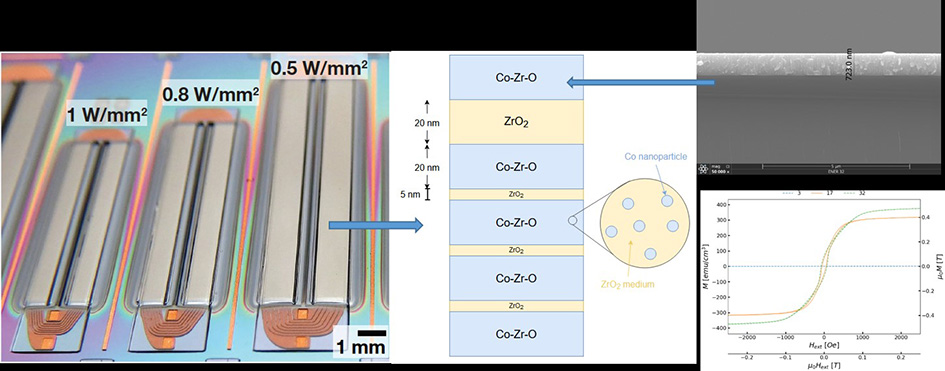Background
Future energy technologies including data center power delivery, grid-scale solid-state smart transformers, advanced granular solar and battery management systems rely significantly more on solid-state electronics than previous technologies. For these technologies, the accompanying passive components and assembly represent a large fraction of the cost. Therefore, on-chip integration of passive components is an important step toward cost-effective advanced energy technologies that will make an impact beyond the pages of a journal. Specifically, integrating magnetic cores on-chip is particularly challenging and valuable. Cored magnetics can be used for power conversion and isolation in ways that capacitors cannot. They can have greatly reduced footprints compared to coreless components that often dominate the die area (= cost) when included on chip. Nevertheless, depositing magnetic materials that are high-quality, back-end-of-line compatible, affordable (fast deposition), and properly tuned for their application is challenging.
This UT-SwRI Energize project was established to support collaboration between experts in power electronics and magnetic materials (UT Austin) as well as experts in large-scale rapid deposition of materials (SwRI) to advance on-chip integration of cored magnetic components. The goal is to establish a high-rate deposition process for magnetic coatings, study magnetic material properties, and provide insights for further optimization through modeling.
Approach
A magnetic thin film material based on Co-Zr-O previously studied by the UT team was selected as the candidate to fabricate high quality on-chip magnetic components. The SwRI team is establishing a high-rate reactive magnetron sputtering process for Co-Zr-O magnetic coatings (>50% faster rate, with potential to scale to 10x surface area). Homogeneous and multilayered Co-Zr-O coatings are being fabricated and characterized to establish the correlation between the deposition process, chemistry, microstructure, and magnetic properties of the coatings. Comprehensive modeling is being conducted by the UT team to provide guidance for further optimization of the magnetic coatings. After successfully developing the deposition process and magnetic coatings, the coating technology will be demonstrated on large area substrates (e.g. 4 inch x 8 inch).
Accomplishments
In the first year, a high-rate deposition process for depositing homogeneous Co-Zr-O coatings has been successfully developed at SwRI. A close-loop reactive gas (O2) partial pressure control system has been integrated into the sputtering process to achieve high deposition rates and precise control of the coating chemistry. The deposition rate for Co-Zr-O coatings was doubled as compared to the previous studies conducted by UT. Different groups of Co-Zr-O coatings have been deposited and characterized in terms of chemistry, microstructure, and magnetic properties. The optimized Co-Zr-O homogenous coating exhibited promising in-plane magnetic hysteresis (M-H) loops measured at room temperature, as shown in Figure 1. In the 2nd year, the team plans to deposit Co-Zr-O magnetic coatings by adopting a multilayer coating design, as shown in Figure 1. A physics-based model of the coating will be developed using the micromagnetic package MuMax3 in the Texas Advanced Computing Center (TACC). At the end of the project, the developed coating technology will be demonstrated on large area substrates.

Figure 1: The proposed Co-Zr-O magnetic coating system (in this case a Co-Zr-O/ZrO2 multilayer design) for on-chip magnetic components. The SEM micrograph shows a Co-Zr-O homogeneous coating deposited by the high-rate reactive sputtering process at SwRI. The coating exhibited promising in-plane magnetic hysteresis (M-H) loops measured at room temperature.
